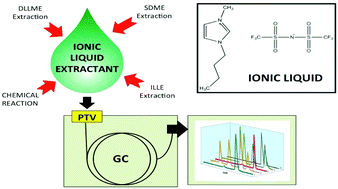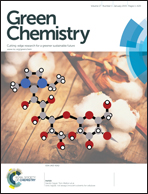Direct ionic liquid extractant injection for volatile chemical analysis – a gas chromatography sampling technique†
Abstract
A green sampling approach by direct injection of ionic liquid (IL) solvent containing a variety of analytes using programmable temperature vaporisation (PTV) injection with gas chromatography (GC) is presented. The method was developed using test mixtures of n-alkanes, n-alcohols and polyaromatic compounds, whilst back extraction of isolated compounds from the IL with organic solvent is not required. In the final method, 2 μL of IL, 1-butyl-3-methylimidazolium bis(trifluoromethylsulfonyl)amide containing analytes, was diluted to different volumes (ranging from 10 to 70%) with solvent then injected into the system. Several PTV injector parameters were investigated to ensure analyte volatilisation and transfer into the GC column. Concentration calibration curves (10–150 μg mL−1 and 10–100 μg mL−1 for n-alkanes and n-alcohols, respectively) were constructed, and showed addition of IL increased the peak area of each analyte, with good precision, and acceptable linearity with correlation coefficient, r2 > 0.93. This method was successfully applied in analysis of a polynuclear aromatic hydrocarbons (PAHs) mixture, with addition of IL in the mixture and suitable operation of the PTV injector. The method was also applied to eucalyptus leaf essential oil compounds as a test sample in a single drop microextraction experiment.


 Please wait while we load your content...
Please wait while we load your content...